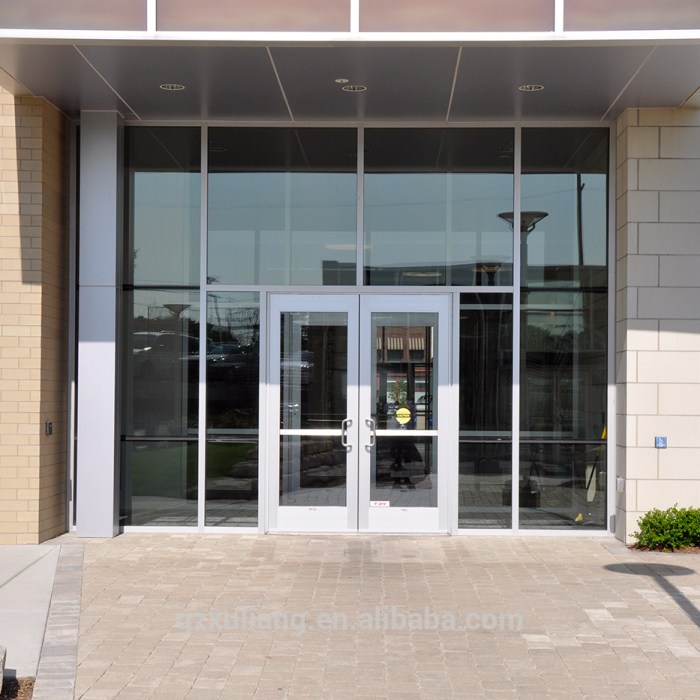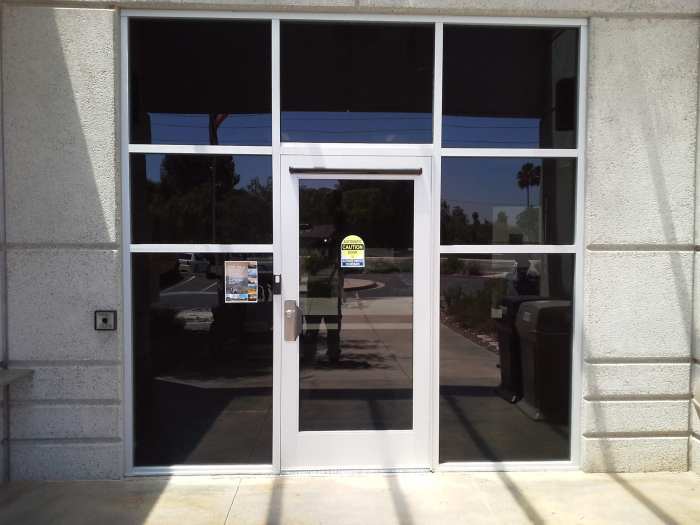Exploring the World of Storefront Doors
Diving into the realm of storefront doors, this article delves into the purpose, materials, design considerations, installation, maintenance, security features, accessibility, and compliance aspects associated with these essential components of commercial buildings.
Overview of Storefront Doors
Storefront doors play a crucial role in commercial buildings as they serve as the main entrance for customers and provide security for the establishment. They are not only functional but also contribute to the overall aesthetic appeal of the building.
Types of Materials Used for Storefront Doors
Storefront doors can be made from various materials, each offering different benefits in terms of durability, security, and aesthetics:
- Aluminum: Lightweight, durable, and low maintenance, commonly used for modern storefront designs.
- Glass: Provides a sleek and sophisticated look, allowing natural light to enter the building, ideal for showcasing products.
- Steel: Offers high security and durability, suitable for high-traffic areas or locations requiring enhanced protection.
- Wood: Adds a classic and warm touch to storefronts, but may require more maintenance compared to other materials.
Importance of Aesthetics and Functionality in Storefront Door Design
When selecting a storefront door design, it is essential to consider both aesthetics and functionality to create a welcoming and secure entrance:
- Aesthetics: The design of the storefront door should complement the overall architecture of the building, attract customers, and reflect the brand image of the business.
- Functionality: The storefront door should be easy to operate, provide security features such as locks and alarms, and ensure smooth customer flow in and out of the establishment.
Installation and Maintenance

Installing a storefront door requires precision and attention to detail to ensure proper function and security. Regular maintenance is essential to prolong the lifespan of the door and keep it looking its best.
Installation of Storefront Door
- Measure the doorway accurately to ensure the correct size door is purchased.
- Remove the existing door and frame, ensuring the area is clean and free of debris.
- Install the new door according to the manufacturer's instructions, making sure it is level and securely attached.
- Test the door to ensure it opens and closes smoothly and locks securely.
Maintenance Practices
Regular maintenance is key to keeping storefront doors in good condition and preventing costly repairs. Some common maintenance practices include:
- Clean the door regularly with mild soap and water to remove dirt and grime.
- Check for any signs of wear and tear, such as loose hinges or damaged weather stripping, and repair as needed.
- Lubricate moving parts, such as hinges and locks, to ensure smooth operation.
- Inspect the door for any cracks or dents and address them promptly to prevent further damage.
Importance of Regular Inspections and Repairs
Regular inspections and repairs are crucial for maintaining the security and functionality of storefront doors. By addressing small issues early on, you can prevent more significant problems down the line and extend the lifespan of the door. Inspections should be done at least twice a year to catch any issues before they escalate.
Security Features
When choosing a storefront door, it is crucial to consider the security features to ensure the safety of your premises. Various elements play a role in enhancing the security of a storefront door, including locks, access control systems, security cameras, and alarms.
Types of Locks and Access Control Systems
- Deadbolt Locks: These are sturdy and reliable locks that provide an extra layer of security.
- Keyless Entry Systems: These systems offer convenience and can be integrated with other security measures.
- Smart Locks: Controlled remotely via a smartphone, smart locks offer flexibility and enhanced security.
Security Cameras and Alarms
- Security Cameras: Installing security cameras can deter potential intruders and provide valuable footage in case of a security breach.
- Alarms: Audible alarms can alert you and others nearby in case of a break-in, while silent alarms can discreetly notify authorities.
Accessibility and Compliance

Ensuring that storefront doors are accessible to individuals with disabilities is crucial for complying with the Americans with Disabilities Act (ADA) regulations. ADA compliance helps create a more inclusive environment for everyone.
Importance of ADA Compliance
ADA compliance for storefront doors is essential to provide equal access to individuals with disabilities. It ensures that everyone, regardless of their physical abilities, can enter and exit a building freely and safely.
Features for Accessibility
- Automatic Door Openers: These devices allow individuals with mobility impairments to easily open doors without physical effort.
- Low Thresholds: Storefront doors with low thresholds make it easier for wheelchair users to enter and exit a building.
- Clear Signage: Clear and visible signage helps individuals with visual impairments navigate the entrance and exit points.
- Wide Clearances: Wide doorways and pathways accommodate individuals using mobility aids such as wheelchairs or walkers.
Regulations and Guidelines
ADA regulations provide specific guidelines for the design and installation of storefront doors to ensure accessibility. Some key requirements include:
"Storefront doors must have a minimum width of 32 inches clear opening width, and the door hardware should be operable with a closed fist."
Following these regulations not only ensures compliance but also demonstrates a commitment to creating an inclusive and welcoming space for all individuals.
Ultimate Conclusion
In conclusion, storefront doors play a crucial role in the functionality, security, and accessibility of commercial spaces. By understanding the different aspects discussed in this article, one can make informed decisions when it comes to selecting, installing, and maintaining storefront doors for their establishments.
Commonly Asked Questions
What are some common materials used for storefront doors?
Common materials include aluminum, glass, steel, and wood, each offering a unique blend of aesthetics and functionality.
Why is ADA compliance important for storefront doors?
ADA compliance ensures that storefront doors are accessible to individuals with disabilities, promoting inclusivity and safety.
How can security cameras enhance storefront door security?
Security cameras provide surveillance and monitoring, enhancing overall security by deterring potential threats and aiding in investigations.




